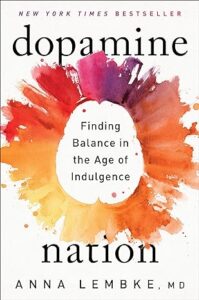We’ve always been enamored with dopamine. And now, we’re enamored with talking about it. Thankfully, I encountered the voice of an intellectual powerhouse.
Below are a few highlights, but don’t let this watered-down garbage prevent you from engaging with the highly-readable, immensely-human, and only 234-page book.
What Is It?
Dopamine has numerous roles in the human body, but when it comes to addiction, the focus is on its job as a neurotransmitter. That’s a small molecule that carries a message from one neuron to another. Dopamine is particularly important in the parts of the brain associated with pleasure—the so-called reward pathways.
When we do something pleasurable, dopamine floods these parts of the brain. The human body, in its constant quest to maintain balance (homeostasis), recognizes the excess. To compensate, the production of dopamine and dopamine receptors can decrease. The consequence is that the next time we engage in the pleasurable activity, we need more of it to feel good. In other words, we’ve developed tolerance, and the seeds of addiction have been sown.
This process, left unabated, can lead us to the point of needing a previously pleasurable substance just to exist. That is, the state of dopamine deficit can be so overwhelming that a substance-free existence seems impossible.
What are such “substances”? Drugs like cocaine and amphetamines, which markedly increase the release of dopamine and thus have profound addictive potential, are clearly in the mix. But so are things like cigarettes, alcohol, food, sex, gambling, shopping, video games, and social media. In our world of abundance, we’re surrounded.
The Pleasure-Pain Balance
It turns out that pleasure and pain are processed in overlapping regions of the brain, meaning they are in constant balance.
As above, a pleasurable stimulus results in an opposing reaction in favor of pain. That pain can manifest with cravings. And as mentioned, the balance can ultimately get tipped to a point where fulfilling a craving merely alleviates pain without providing pleasure.
In order to recreate a proper balance, abstinence—or dopamine fasting—is key. Typically, a four-week hiatus is required. At that point, depending on what tipped the scales in the first place, reintroduction can be considered. Achieving moderation, however, may be just as difficult as it was the first time around, leaving abstinence as an easier option for some.
Practical Tips
Don’t start. This is always reasonable advice, even to avoid food addiction, in which non-healthy choices rule the roost. With regards to alcohol, normalization does not equal normal. As a parent, you probably don’t encourage trying cocaine—so why alcohol?
Take a break. If you depend on something to make you feel happy, take a break (as long as the break itself isn’t life-threatening). If the cravings are intense, consider medication. As an example, the opioid receptor blocker naltrexone can blunt the reinforcing effects of rewarding behavior, facilitating moderation and abstinence.
Beware of downtime. Remember that free time isn’t always your friend.
Boost dopamine the natural way. Given the pleasure-pain balance, embracing pain can actually lead to a rebound in pleasure (as is the case the other way around). In other words, a cold shower (i.e. cold-water therapy), fasting, and exercise can lead to a surge in dopamine. Like with anything else, reasonable limits must be applied.
Also, remember that we’re surrounded by benign sources of dopamine: the sunrise, learning, music, the wonders of the natural world, and so on. Know the science, and use it to your advantage.
And finally, be honest. Tell the truth to those around you and, most importantly, yourself.
Now go read the book!

4 Responses
Shopping can also give a high, although it can also add to the credit card bills 😂
No doubt! Abstinence comes easy to me with that one though. 🙂
Good article and good book
Thank you. I agree—the book is excellent.